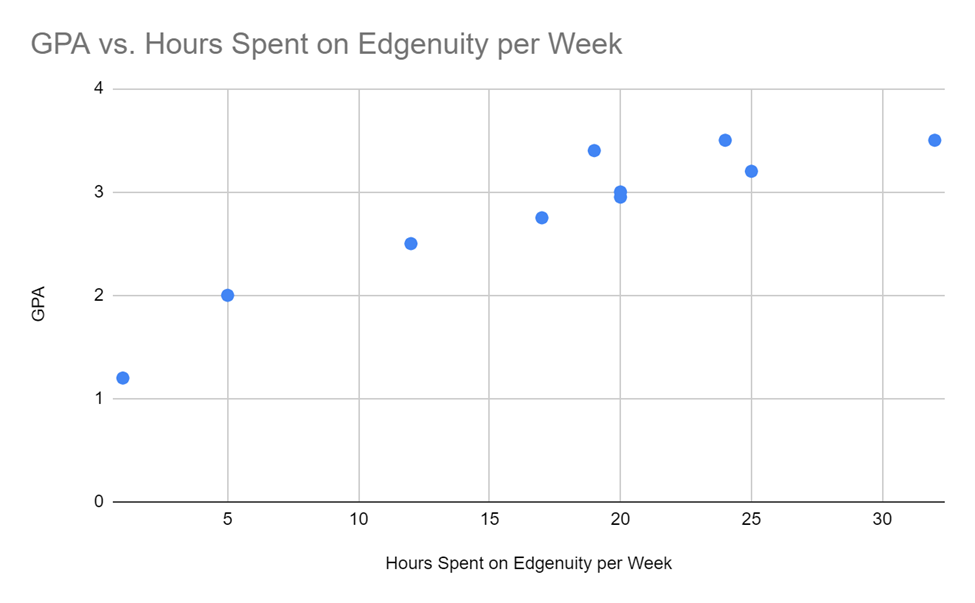AZUL, ANNAVIE
Page Navigation
- Patrick J. DiPaolo Student Success Center at Emerson-Gridley
- Class Resources
-
ALGEBRA 1 KEYSTONE Reviewer by KHAN ACADEMY

Please click on the links to access the pages below:
Module 1
1.1 Operations
Combining Like Terms
Exponent Rules
Exponent Rules Continued
Simplifying Expressions with Exponents
Multiplying Polynomials
Factoring Difference of Squares
Simplifying Radicals1.2 Linear Equations and Systems
Writing Expressions
Linear_Equations
Linear_Equation_Word_Problems
Systems of Equations with Elimination Part:1
Systems of Equations with Elimination
Systems of Equations with Substitution
Systems of Equations Word Problems1.3 Linear Inequalities and Systems of Inequalities
Linear Inequalities
Graphs of Inequalities
Graphing Systems of InequalitiesModule 2
2.1 Functions and Patterns
Domain and Range
Identifying_Points
Finding Equations of Lines from Tables2.2 Coordinate Geometry
Slope of a Line
Solving_for_the_y-intercept
Line Graph Intuition
Graphing Linear Equations
Gaphing Linear Functions to Solve Systems (Includes Module 1 practice.)
Slope Intercept Form
Converting between Slope Intercept and Standard Form
Point Slope Form2.3 Probability and Data Analysis
Probability
Additional Probability
Independent_Probability
Stem_and_Leaf_Plots
Mean, Median_and_Mode
Box_and_Whisker_Plots
-
WHAT IS PBL or Project-based Learning?
Learn more about Project-Based Learning or PBL by clicking on this link or check this QR Code below:

-
What is Budgeting?
Financial Literacy lesson with Khan Academy explains the definition of a budget and how you can use the 50-30-20 rule.
Click this link: https://www.khanacademy.org/college-careers-more/financial-literacy/xa6995ea67a8e9fdd:budgeting-and-saving/xa6995ea67a8e9fdd:budgeting/a/what-is-a-budget
-
How to Set Financial Goals?
-
How to set Financial Goals?
Amy Fontinelle, a contributor from Investopedia discussed the different types of financial goals and provided steps on how to be financially secure in the future.
Check her blog through this link: https://www.investopedia.com/articles/personal-finance/100516/setting-financial-goals/
-
-
What is a Flipped Classroom and How Can it Benefit Your Students?
Posted by Annavie Azul on 2/18/2023Title: What is a Flipped Classroom and How Can it Benefit Your Students?
Introduction:
The traditional classroom has been the cornerstone of education for centuries, but with advances in technology and changes in teaching methodologies, educators are looking for new ways to engage and motivate their students (Bergman & Sams, 2012). One such approach is the flipped classroom. In a flipped classroom, the traditional model of instruction is inverted: students watch recorded lectures at home and then come to class to engage in activities and discussions. This blog post will provide an overview of the flipped classroom and explore its benefits for both teachers and students (Bishop & Verleger, 2013).
What is a Flipped Classroom?
A flipped classroom is a teaching model that aims to increase student engagement and interaction by reversing the traditional instructional format. Instead of listening to lectures during class time and completing homework assignments at home, students watch recorded lectures or read materials outside of class and then come to class to engage in activities and discussions (Mason, Shuman, Cook, 2013). In other words, the "homework" is done in class and the "lecture" is done at home.
The benefits of a Flipped Classroom
Active Learning: In a flipped classroom, students have more opportunities to engage in active learning, which has been shown to improve academic performance. By engaging in discussions and activities during class time, students are able to apply the knowledge they have gained through pre-class activities (Freeman, et al, 2014).
Flexibility: A flipped classroom provides more flexibility in terms of when and where students can learn. Students can watch lectures and complete assignments at their own pace and at a time that suits them (Vliet, Winnips & Brouwer, 2015).
Personalization: A flipped classroom can be tailored to meet the needs of individual students. Students who need extra help or additional resources can access them at any time, and those who are ahead of the class can move on to more advanced materials.
Teacher-Student Interaction: With more time for student-teacher interaction, educators can provide more personalized attention and support to each student. They can address questions and concerns in real-time, and provide more immediate feedback (Tucker, 2012).
Increased Student Engagement: Flipped classrooms have been shown to increase student engagement and motivation, leading to improved academic performance and better student outcomes (Strayer, 2012).
Conclusion:
The flipped classroom is a teaching approach that has gained popularity in recent years due to its potential to improve student engagement and performance. By inverting the traditional model of instruction, students have more opportunities for active learning, personalization, and flexibility. Teachers can provide more individualized support and attention, leading to better student outcomes. While the flipped classroom is not without its challenges, its benefits make it a valuable approach for educators looking to improve student learning and engagement.
References:
Bergmann, J., & Sams, A. (2012). Flip your classroom: Reach every student in every class every day. International Society for Technology in Education.
Bishop, J. L., & Verleger, M. A. (2013). The flipped classroom: A survey of the research. In ASEE National Conference Proceedings, Atlanta, GA.
Freeman, S., Eddy, S. L., McDonough, M., Smith, M. K., Okoroafor, N., Jordt, H., & Wenderoth, M. P. (2014). Active learning increases student performance in science, engineering, and mathematics. Proceedings of the National Academy of Sciences, 111(23), 8410-8415.
Mason, G. S., Shuman, T. R., & Cook, K. E. (2013). Comparing the effectiveness of an inverted classroom to a traditional classroom in an upper-division engineering course. IEEE Transactions on Education, 56(4), 430-435.
Strayer, J. F. (2012). How learning in an inverted classroom influences cooperation, innovation, and task orientation. Learning Environments Research, 15(2), 171-193.
Tucker, B. (2012). The flipped classroom. Education Next, 12(1), 82-83.
Van Vliet, E. A., Winnips, J. C., & Brouwer, N. (2015). Flipped-classroom approach increases academic performance in undergraduate genetics. CBE-Life Sciences Education, 14(4), ar36.
-
Title: How Technology is Revolutionizing Math Education
Posted by Annavie Azul on 2/10/2023Title: How Technology is Revolutionizing Math Education
Mathematics has long been a subject that students struggle with, often finding it tedious, dry, and difficult to engage with. Fortunately, technology is now revolutionizing math education and making it easier than ever for students to learn, engage with, and enjoy the subject. Here are a few ways that technology is transforming the way we teach and learn math:
Interactive simulations and visualizations: Math concepts can often be abstract and difficult to visualize, but interactive simulations and visualizations can bring them to life. For example, virtual manipulatives can help students understand fractions and decimals by letting them see how these concepts work in real-time. Graphing calculators and geometry software can help students explore complex shapes and equations, making it easier to understand them.
Adaptive learning: Adaptive learning technology is becoming more common in math education. These systems use algorithms to assess a student's strengths and weaknesses and adjust the content and difficulty level of the material accordingly. This makes learning math more personalized and efficient, allowing students to focus on areas where they need more support.
Gamification: Games are a great way to engage students and make learning math more fun. Math games can help students build skills such as problem-solving, critical thinking, and logic. They can also help students practice math in a low-stakes, low-pressure environment. Many math apps and online games are available for students to play on their computers, tablets, or smartphones.
Online collaboration and resources: With the rise of online learning, there are now a wealth of resources available for students to learn math. Online textbooks, video lectures, and math forums can help students learn from anywhere, at any time. Online collaboration tools like shared whiteboards and chat rooms can also help students work together on math problems and get help from their peers.
In conclusion, technology is changing the way we teach and learn math. With interactive simulations, adaptive learning, gamification, and online collaboration, students now have more resources than ever to help them succeed in math. As technology continues to evolve, we can look forward to even more innovative ways to engage students and make math education accessible and enjoyable for all.
-
21st Century Teachers
Posted by Annavie Azul on 1/25/2023In an article published in 2022 by Guillen-Gamez and Mayorga-Fernandez about measuring rural teachers' digital competence to communicate with the educational community, they utilized a non-experimental, ex post facto qualitative methodology to determine the digital competence of the teachers in rural areas regarding their application of ICT resources to communicate with other teachers, students, and families based on their gender, type of school, age and years of teaching experience. They also sought to analyze the significant differences in terms of the level of digital competence among the teachers. They also wanted to identify which digital resources are significant predictors. They conducted it among 847 rural teachers from different rural areas in Spain. The study also takes into consideration the demographics of 68.6 % (n-581) females and 31.4 % (n-266) males. Where on average of age, 41.80 years old for females and 43.84 years old for males. The self-assessment questionnaire designed by Rufete, Cascales, and Gomariz was used in this study. They developed three dimensions to ensure its reliability and validity. First, the tutor’s interactions with students. Second is the tutor’s functions in relation to the teaching staff. Third, the tutor’s functions regarding the families of the students. The study also used a five-point Likert scale to measure the level of development of teachers based on their digital competence. The result of their study for each dimension suggested that male teachers assessed themselves to be more competent than their female counterparts. However, there is no significant difference between genders when it comes to working within an educational context based on their age and years of teaching experience.
One of the things that stood out in this research is the timely topic on teachers’ competence when it comes to communication with the educational community over the use of technology. As countries progress throughout the 21st century, teachers must also be able to cope with these changes in educational development. This includes the utilization of ICT resources. Their study will lead to future research studies because of its relevance and timely nature. Specifically, when the world experienced a historical pandemic in 2019-2021, it changed the trajectory of educational processes. Where even the teachers and students in rural areas should not be left behind by all these ICT advancements.
What will I do as a Cyber Teacher?
The content of the study helped me realize the importance of the use of ICT resources in communicating with the educational community. Although I was not born in the digital age, as a teacher, it is my obligation to advance myself in adapting to these changes. Our focus is always on the students, who also form part of the 21st-century era where they have intuitively developed their ease with the use of technology. Thus, it is imperative that I should learn all these Blogs, Twitter, WhatsApp, TikTok, etc., and other social and technological platforms in reaching out to the students to contribute to the development of their academic learning and other social factors. Furthermore, as a 21st century cyber teacher using Edgenuity website and other ICT resources, I will strive and thrive with all these technological advancements.
-
Did you know?
Posted by Annavie Azul on 1/24/2023Did you know that you can create a Scatter Plot diagram using Google Sheets?
Yes, you can use technology to simplify your tasks. For those who are enrolled in Cyber School using Edgenuity, one of your performance tasks in Algebra 1 is the Super Survey Simulator. Your task is to conduct a survey among the students (you may ask your classmates, your friends, your neighbors) about the hours they spent studying and their GPA scores.
You are going to enter the results of your survey on Google Sheets. Create a column for the students, their hours spent and their GPA's. Then, highlight the column for hours spent and GPA, then click the Insert TAB, find the Chart in the dropdown box. It will default to the Scatter Plot chart. Voila, you have your graph!
See example below:
Student Hours Spent on Edgenuity per Week GPA 1 25 3.2 2 5 2 3 17 2.75 4 20 3 5 32 3.5 6 19 3.4 7 1 1.2 8 24 3.5 9 20 2.95 10 12 2.5 

